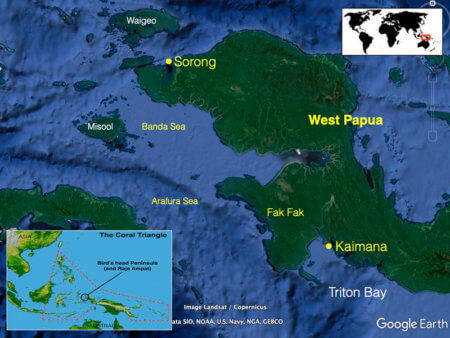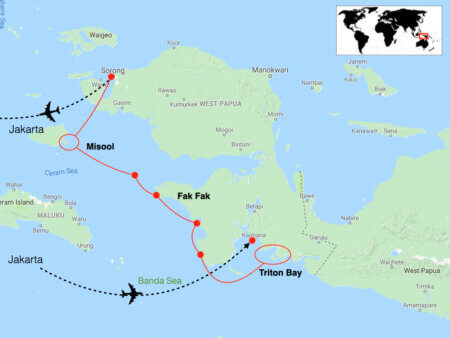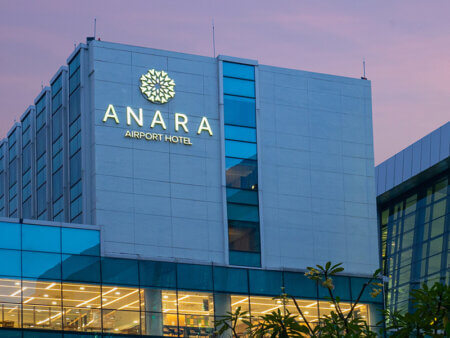Triton Bay to Raja Ampat Snorkeling Tour
 Triton Bay is located off the southwestern tip of West Papua (Indonesia) and is part of the Bird’s Head Seascape, a protected region that comprises the coastal waters around the entire west coast of the island of New Guinea. This way-off-the-beaten-path destination is a throwback to the way people around New Guinea existed 50 years ago. Lush tropical forests and quiet coves with perfect white sand beaches can be found throughout the rugged coastline and jungle-clad islands. With few commercial exports, island life revolves around subsistence living (fishing and agriculture) and the main town of Kaimana, the center of import and commerce in the region, boasts population of 13,000 residents.
Triton Bay is located off the southwestern tip of West Papua (Indonesia) and is part of the Bird’s Head Seascape, a protected region that comprises the coastal waters around the entire west coast of the island of New Guinea. This way-off-the-beaten-path destination is a throwback to the way people around New Guinea existed 50 years ago. Lush tropical forests and quiet coves with perfect white sand beaches can be found throughout the rugged coastline and jungle-clad islands. With few commercial exports, island life revolves around subsistence living (fishing and agriculture) and the main town of Kaimana, the center of import and commerce in the region, boasts population of 13,000 residents.
x
Scientists and marine naturalists, however, are quickly recognizing this area for its diversity of marine life and habitats. The Kaimana regency of which Triton Bay is a part, is also referred to as the “Kingdom of Fishes”. Like its more popular northern neighbor, Raja Ampat, Triton Bay has some of the highest levels of marine biodiversity on the planet. All of the usual parameters apply; over five hundred species of hard corals and well over one thousand species of fishes.
x
Further highlights include whale sharks, and chances to see endemic species such as the Triton Bay walking shark and Giti’s damselfish. Given the marine diversity and abundance that is comparable to Raja Ampat and that only handful of tourists visit the area each year, Triton Bay may just be one of Indonesia’s best kept secret. Our snorkeling tour takes us along the west coast of Bird’s Head Peninsula where powerful waterfalls, colonies of fruit bats that number in the thousands, awe-inspiring geology and the chance to snorkel the best reefs and habitats in Triton Bay and Raja Ampat.
ITINERARY
Our snorkeling tour begins and ends in Jakarta, Indonesia. Our outbound flights departs Jakarta for Kaimana, West Papua, where we meet with our live aboard boat. We’ll spend a few days in Triton Bay before turning north and hopping along the West Papuan coast for a couple of days before turning northwest towards Misool, Raja Ampat. We disembark in Sorong for our flight back to Jakarta. It is possible that this itinerary may be run in reverse.
Jakarta, Indonesia. Our outbound flights departs Jakarta for Kaimana, West Papua, where we meet with our live aboard boat. We’ll spend a few days in Triton Bay before turning north and hopping along the West Papuan coast for a couple of days before turning northwest towards Misool, Raja Ampat. We disembark in Sorong for our flight back to Jakarta. It is possible that this itinerary may be run in reverse.
Day 1: Jakarta / Anara Airport Hotel, Jakarta
Meals provided: D
Meet in Jakarta, Indonesia at our group hotel, the Anara Airport Hotel, for the tour orientation and welcome dinner. As is often the case with our internal flight, we will depart for Sorong in the late evening, thus our ‘overnight’ will be in transit to Sorong. Overnight: Anara Airport Hotel.
Day 2: Kaimana / Triton Bay
Meals provided: B,L,D
Fly to Sorong and transfer to our liveaboard boat. Boat orientation and lunch before we depart for our snorkeling adventure into Triton Bay. While we do not plan to have the chance to snorkel today, if time and weather permits, we will give it our best. Overnight:
Day 3 – 5: Triton Bay / Whale Sharks
Meals provided: B,L,D
We spend the net few days cruising south along the rugged West Papuan coast towards Triton Bay, along the way, snorkeling pristine reefs and exploring quiet lagoons and hidden bays. Triton Bay possesses every type of marine habitat and we will spend the next four days exploring many of them on our quest to see the world’s healthiest and dazzling reefs. Shallow fringing reefs, clear mangroves, colorful coral gardens, fields of seagrasses, and tens of thousands of dazzling marine fishes will be the story of the day while in Triton Bay. We will also have the chance to snorkel with whale sharks that have taken up residency near local fishing platforms (called Bagans) in the Bay. We’ll also have the opportunity to see rare birds and admire the raw, prehistoric jungle landscape that dominates along the coastline. Overnight:
Day 6: Momon / Waterfalls / Fruit bats
Meals provided: B,L,D
With the steep coastline on our right, we begin our northward cruise with the first stop at Momon a beautiful bay carved into the sharp volcanic terrain. Hard and soft corals grow over boulders that have accumulated along the coastline, creating small grottos and passageway often shaded by thick branches from trees that perch above the waterline. We will also visit a waterfall that drops huge volumes of fresh water directly into the ocean and in with the waning sunset, we will visit a colony of fruit bats that cling to short, but steep limestone cliffs during the day, waiting to venture out at night to feed on nuts and fruits. Overnight:
Day 7: Karas / Collapsed cave
Meals provided: B,L,D
One of the more awe-inspiring limestone features are collapsed caves, and having one that is incorporated into a fringing reef system is a snorkeler’s dream. The lack of roof allows sunlight into parts of the cave, resulting in patches of live coral amongst the dark shadows of the cave environment. The deep cave also has steep walls, examples of both stalagmites and stalactites, drip curtains, grottos, and as shallow and healthy reef at the entrance. We will also snorkel in a series of bays where shallow coral reef and gardens capture our attention for hours on end. Overnight:
Day 8: TG Putih / Pisang
Meals provided: B,L,D
Just north of Fak Fak lies TG Putih, a network of reef systems connect rock, sand, and mangrove islands strewn around the bay. Staghorn coral dominates the reef community with associated schools of blue-green chromes that hover in dense schools above. In the afternoon we visit Pisang where unspoiled beaches invite us for a picnic after a long morning of snorkeling the semi-protected reef environments that reside on the leeward side of the island. Overnight:
Day 9 – 12: Misool / Raja Ampat / Wayil / Segaf / Balbulol
Meals provided: B,L,D
Misool is known for its incredible scenery comprised mostly of jungle-clad limestone islands and islets. The reefs fringe from the islands and often drop in dramatic wall-like fashion providing us with the chance to snorkel over shallow coral reef and look out into the deep blue where the bigger fish are spending time. We will snorkel around the islands of Wayil, Segaf, Balbulol and Len Kafal we have the chance to sites that include swift passes between the islands where colorful soft corals create beautiful complex homes for the thousands of reef fish that feed nearby in the currents and quiet lagoons with shallow reefs where dozens of species of juvenile reef fishes gain experience. Overnight:
Day 13: Sorong / Anara Airport Hotel
Meals provided: B,L,D
Disembark in the morning and transfer to the airport for our return flight to Jakarta. Overnight: Anara Airport Hotel
Day 14: International flights or extensions
Meals provided: B
Departures
We are exploring dates in 2026 ←Click to request a booking
Accommodations:
Guides: TBD
Length: 14 days
Prices and Payment schedule:
$TBD per person, double occupancy
$TBD per person, single occupancy
Reservation deposit: $500 USD
Jan 1, 2026: $ USD / $ single
October 1, 2026: $ USD / $ single
Tour cost includes:
- Accommodations on day 1 through day 14
- All meals on days 2 through 13 (dinner on day 1 – breakfast on day 14)
- All internal transfers including international arrival and departure transfers
- Non-alcoholic beverages
- All snorkeling and park fees
- All gratuities
Tour cost does not include:
- Round-trip international airfare
- Additional hotel accommodations and meals as a result of travel outside of the program dates
- Visa requirements including payments
- Alcoholic beverages
- International departure taxes
- Extra / overweight baggage fees
- Trip insurance (recommended; (we recommend Travel Guard, World Nomads, or Travel Insure)
DAN insurance (required unless personal insurance program has worldwide emergency evacuation services) - Additional accommodations while on tour in the event of flight schedule changes or events of force majeure
- Fuel surcharges (if applicable)
Cancellation policy:
180 – 91 days prior to departure: 50% of trip cost
90 days or less prior to departure: 100% of tour cost
Please see our Terms and Conditions for more information
ACCOMMODATIONS
Anara Airport Hotel is the only integrated hotel with Terminal 3 International Airport Soekarno-Hatta. We present you an experience a new level of comfort to indulge yourself all day. As the 4-star hotel, Anara Airport Hotel has deluxe rooms (28 sqm) with king or twin accommodations, free wi-fi, flatscreen TV with cable and satellite, work desk and chair, hair dryer, mini cooler, and coffee/tea maker. Explore authentic Asian and delightful international cuisines at the Selasih restaurant or relax in the ambiance of the Lobby Lounge. Onsite facilities include a wellness spa and gym and four functional/meeting rooms. The easy access from the international and domestic terminals combined with the elegance of a modern 4-star hotel makes Anara Airport Hotel the perfect choice for business and leisure travelers.
WHAT TO EXPECT
The islands in Raja Ampat nearly straddle the zeroth latitude, with most of them residing in the southern hemisphere. Triton Bay is located about four degrees south of the Equator. Residing on and near the equator, weather year round is hot and humid, with the chance of daily rain showers occurring in the early morning or late afternoon. Daytime temperatures hover around 86º F (30º C) and do not change much at night. Water temperatures average around 82º F (28º C), though cooler temperatures may occur if persistent rains cause a thin layer of cool freshwater on the surface.
Currents around Triton Bay and Raja Ampat may be strong. While we plan our snorkel session around the slack tides, we also have several sites where having water movement is an advantage. These drift snorkels allow us to cover large tracks of reef without having to swim too hard. Our snorkel sessions are 100% boat supported and they will be there at all times to assist anyone for whatever reason.
Please read more about our daily schedule.
WHAT TO BRING
The following list is a suggestion of things to bring and applies to almost all our trips. Specific items on a particular departure will be noted on the departure information.
-A good fitting mask, snorkel, and set of fins. If your equipment is brand new, please try it out in the pool. Determining the fit and function of your equipment in the pool includes doing several laps with all your equipment on. Doing several snorkel dives is also very beneficial. It is also important to clean your new equipment, especially your mask. Cleaning procedures for your mask include light scrubbing with toothpaste or dishwasher soap to remove the layer of silicon used to preserve the mask during shipping. Clean both sides of the mask. Doing this greatly reduces the chances of having your mask fog. Not doing this, even when using mask de-fogger, usually results in a fogged mask.
-A wetsuit, rash guard, diveskin, or any type of clothing that can be used for thermal and/or protection from the sun. We suggest bringing a full 3mm wetsuit and some type of core insulation like a vest or shirt made of 1 – 2 mm neoprene (e.g., Lavacore or Sharkskin shirts or vests). These items will not only provide thermal protection but protection from the sun as well. For those who feel that a 3mm suit may be too warm, please consider a full body skin or rash guard to ensure protection from the sun. With regards to thermal protection, remember the saying: It is better to have and not need, than to need and not have. One that note…
-Head protection in the form of a wetsuit hood, a cap, or even a bandana. Anything that can keep the sun off your head is extremely important. It is the most exposed part of our bodies when we are floating on the surface.
-Underwater flashlight on departures with a planned night snorkel
-Biodegradable sunscreen lotion. Sunscreen lotions can be harmful and even kill tiny larvae (baby marine life). It is fine to wear on land, but we highly discourage the use of sunscreen lotions in the water. A full wetsuit or dive skin will protect one from the sun much better than lotions and provide thermal protection. It is truly a win-win for everyone and the marine environment.
-Casual, lightweight, tropical clothing
-Sunglasses (and a spare in case you lose your main pair)
-Comfortable footwear such as active sandals (Teva, Keen, Merrell, etc.)
-Hats. We cannot stress the importance of a hat in the tropics!
-All our boats provide items like shampoo, soap, towels, etc. We bring this up because these items represent added weight or may leak.
Other items to consider:
-Lightweight rainwear to protect from the occasional afternoon shower
-Binoculars


